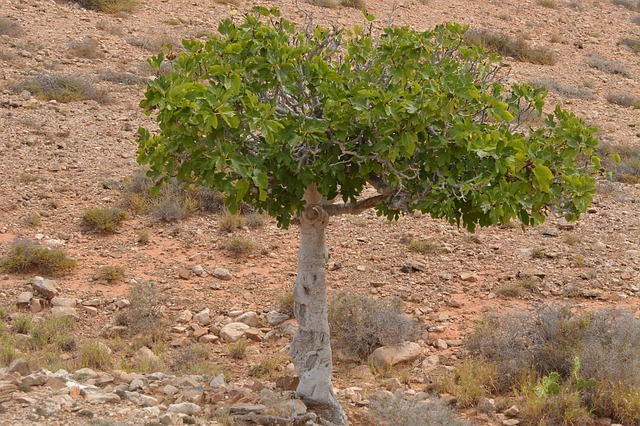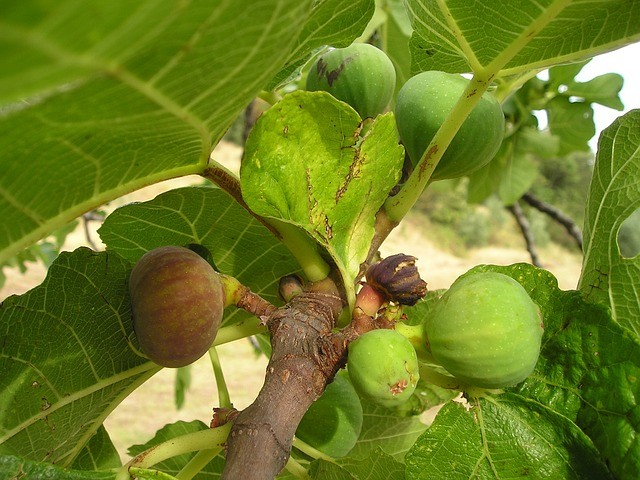New fig trees species, an unusual find in Spain

Green and purple figs on a plate image Antonio Alba
Some historical facts on the fig tree
The amazing Fig Tree or Ficus carica is an Asian species of the mulberry family. It is native to the Middle East and western Asia but present for many centuries in the south of Europe.
It can grow from sea level up to 1.700 meters and prefers relatively light free-draining soils.
Most fig species require to be pollinated by the fig wasp or another tree, but for the Ficus carica, this does not always apply. The fig tree was one of the first trees to be cultivated by men.
They found some subfossil figs in the Neolithic village Gilgal in the Jordan Valley. They could date them at 9400-9200BC.

Fig tree growing on barren land image Ben Kerckx
In Greece, fig-trees were very common. Aristotle and also Theophrastus both wrote about this fruit. For the Romans, it was a common food source. Cato the Elder wrote about the different fig types in his De Agri Cultura from 160 BC.
One special detail is that figs were used to fatten up geese. The first self-pollinating figs were brought to California in 1769 by Junipero Serra, one of a group of Spanish missionaries.
Data of 2014 on the total world production of raw figs was some 1.14 million tonnes, Turkey, Egypt, Algeria, and Morocco being the four largest producers.
We can eat figs in different ways. They do not keep well when harvested. When figs smell slightly sour, they are overripe and if still a bit hard will ripen in about 2 days. Eat them as they are, with ice cream, as fig jam, on cakes, and in cookies. They are delicious when made into a smoothie.
Have a look at this YouTube video on how to grow a fig tree. It is not too difficult. You can even have a small tree standing on your balcony. Have a go, you might be surprised.
In the Bible, the fig is mentioned numerous times. Adam and Eve, after eating from the Tree of Knowledge of Good and Evil, clad themselves with fig leaves.
Buddha sitting under an ancient and big fig tree achieved enlightenment. Muhammad said that eating this fruit would prevent hemorrhoids, piles, and help with gout. There are many examples in history where the fig tree is mentioned.

Figs growing on a tree image Simon Steinberger
My experience with figs
I live in the south of Spain, to be more precise in the province of Malaga. In 1981 I was so lucky to find an old ruin, at that time 150-years-old, and over the years reconditioned during various building adventures in this beautiful place.
As it has quite a bit of land, I can grow a lot of things myself and of course planted a fig tree. A fig tree can adapt itself to a big variety of soils and climates, but here in my place, it grew well so it must have been happy. It grew so big that in winter when it has no leaves the top had to be cut.
It was getting so big one could not reach the fruit anymore and it also started to obstruct the pretty sunsets on the west side of my patio.
In June you will get the first harvest. These are figs that have been “sleeping” since the previous year, going through winter, to then mature months later. Then, at the end of the summer, the new harvest is ready. These are figs, which have grown during the same year on the new sprouts of the tree. This harvest lasts about 3 months if the birds permit. The fallen figs we rake together and give them to the ducks and chickens.

Amazing Sunset
What is in a fig
If you eat your figs fresh from the tree, they do not have a lot of calories, 65 for 100 grams.
In case you eat dried figs, then the calories double because of the higher sugar content.
A fig has carbon hydrate, fiber, potassium, proteins, minerals like iron, magnesium, copper, zinc, and vitamins. Fig marmalade, homemade, is very nice, and cold from the fridge with ice cream. You can put them in a fruit smoothie and together with different cheeses. Figs are healthy and great to taste.

Big Fig, own harvest
Unknown fig species discovered
In the Guadalhorce area close to Malaga, we can find different types of figs. Of many from these not well-known varieties, only a few trees remain. Some old farmers took care of them. This has come to light as Monica Laguia, who is an ecological farmer, was writing for her Masters at the International University of Andalucia.
In collaboration with GDR and the Experimental Center “La Mayora “, it was discovered that the ADN of 11 of the 18 varieties did not coincide with any of the registered trees in the Germoplasma Bank of Extremadura, national reference catalog. The idea is to create a network to interchange seeds and like that be able to recuperate these nearly lost species of fig trees.
This is such a yummy cookbook
The award-winning cookbook author Marie Simmons leaves no fig or fig leaf unturned. She takes you on a mouthwatering trip to show you the possibilities of this extraordinary fruit.
70 delicious recipes from salt to sweet are waiting for you to try. You will not be disappointed.
Conclusion
The fig is a very healthy fruit, and it also tastes delicious. As the season is quite short, you should eat this fruit often.
I have tried to deep-freeze them, like 6 fruits in a pack. Once defrosted they are not as pretty as when fresh but are still very good to eat mixed with other fruits and yogurt or used for a smoothie. As this year the harvest was rather big, I did this experiment and now have 18 portions to enjoy this winter.
Before you leave, you might like to visit Recommendations. This is a special page I made for you with a collection of things I like. I hope you will find something of your interest too.
Source: Sur Newspaper
Photo Source: Pixabay and Private.
Nature is amazing and holds many health surprises. Perhaps you want to have a look at the following post too.











Comments
Danielle
Oh figs, figs! This is a fruit I can never have enough of. I am amazed by how many different varieties there is.
The story of the fig wasp and the fig is also an amazing one. It almost put me off eating figs but thank goodness that some species do not need a wasp to ripen or be pollinate them.
Thank you for such a comprehensive article. The fig tree has been with us for ages. Enjoy your figs and have a lovely day.
~Danielle
Taetske
Good afternoon Danielle,
Thank you for reading my post on figs. I find it an amazing fruit and it has such a great taste. Going to the tree and chose a ripe fig warmed by the sun and eat it there and then, it is lovely. Have you ever tried this smoothie? 4 ripe figs, a Greek natural yogurt, 1 ripe banana, some lemon juice and 2 spoons of honey. This you mix with one of those hand mixers. You can put it to cool in the fridge, it is like a lunch. You can also do this with an avocado, so good and healthy. I was happy to read those unknown species had been found in the south of Spain, actually close to where I live. That was a nice gift of Mother Nature.
Regards, Taetske
Danielle
Thank you for the smoothie recipe Taetske. Unfortunately I don’t have ripe figs in my tree anymore at the moment. I have two avocados in my house today though. So I will use the avocados instead.
Thank you Taetske.
~Danielle
Daniel
I must say that enjoy reading this post Taetske. For me, figs are one of the most healthiest and most delicious fruits in the world. I don’t know why I like it that much. I am glad that a new species are discovered because it is always better to have more. My mom like to make cakes with figs, it is fantastic. Thank you for sharing this great news with us.
Taetske
Good Morning Daniel,
I was also happy to find out about these new fig trees. Normally one always reads species are disappearing so this was good news. You should try figs in a smoothie together with a banana, greek yogurt, some honey and the juice of a lemon, comes out really tasty.
Thank you for your comment, hope to see you again.
Regards, Taetske
Dianne
I absolutely love figs! And wasnt never really aware of how many nutrients they contain so thank you. This article is great!
You say that fig trees can adapt to a variety of soils and climates this is great news that I never knew!
I live in the UK so in your opinion how would i get on with growing my own fig tree?
Taetske
Good Morning Dianne,
Thank you for leaving a comment on my website. I hope you downloaded your free PDF?
I live in the south of Spain and fig trees do very well here. In summer it might get a bit hot for awhile like 40C but the fig tree does not mind. In winter it reaches just above 0C. Therefore I think that the temperature might be too cold in the UK and perhaps you also lack some sunshine. Now if you have space why not try to grow it inside and put the pot outside in the summer?
Regards, Taetske
akshaysaxena
Awesome, you really tempted me to try figs 🙂
You have even covered religious background to prove the importance of the fig tree. That’s great.
In my view, It is detailed and to the point, focused post to learn fig in better ways. I didn’t know much about it earlier. Thank you for sharing your cool knowledge.
Cheers
Akshay
Taetske
Good Morning Akshaysaxena,
Thank you for visiting my website and leaving a comment. I hope you downloaded your free PDF?
Often when you write about nature and natural things it has a long history. I like to give a little information also on the background. Nice to hear you liked my post and got some useful information from it. Do not wait, figs are delicious
Regards, Taetske.
Louis
Hello Taetske,
I really enjoy eating figs but never knew of the nutritional benefits of this fruit. I actually like adding fresh figs to my salad because of it’s sweet succulent taste.
If I were to plant a fig tree of my own, how long will it take for the tree to blossom and bear fruits?
Taetske
Good Morning Louis,
The fig is a very healthy fruit to eat. To answer your question, a fig tree does not have blossom. The fruit is the blossom but like an inverted flower. It will take like 4 to 5 years before you will get figs from your new tree.
Thank you for your comment. I hope you downloaded your free PDF?
Regards, Taetske
abioye olalekan
This is an awesome post and it’s incredibly attractive to read, I must give you Kudos for finding time to package all these reviews together about fig species.
You have highlighted the advantages of fig which I really learned a lot. Now, what are the disadvantages attached to fig leaf?
In which other locations can we get these figs apart from South Spain?
Taetske
Good Morning Abioye,
Nice to hear you enjoyed my post.
As to your question, there are many places in the world where figs are grown. Turkey, Spain, Greece, Egypt, Syria, Algeria, Tunisia, Marocco, and California. I am sure I have missed some. I am not aware that there are any disadvantages. The only thing I can think of is overeating, might cause some very good digestion.
Thank you for leaving a comment. I hope you have downloaded your free PDF?
Regards, Taetske
Joy gateru
What a great and informative post, personally I have know the fig tree since childhood, to my surprise is that fig tree is worldwide recognised, from where I come from, we don’t eat the fruits from the fig tree, as it is said that it was cursed long time ago when Jesus was on earth, I really don’t know whether it’s true or it’s just a myth, but after reading this post I am surprised that people enjoy the same fruit without any worries, actually by now I am tempted to try it out and eat some soon, I really appreciate for coming across this post, I am sure to subscribe to your newsfeed to learn more about this and other posts, thank you.
From Joy.
Taetske
Good Morning Joy.
Thank you for visiting my website and leaving a comment. I hope you downloaded your free PDF?
I would put this down as a myth. God created the garden of Eden, including the fig tree. How would Jesus criticize the work of his Father?
I hope you will taste this good fruit one day.
Regards, Taetske
Clement
Thank you for this great post, I find it really helpful and nice. you have heard about how well and delicious fig fruits always tasted but I have never tasted it. It is not common to come by in those parts of Africa. I will try to get hold of the fruits anytime I come for vacation in Spain.
Taetske
Good Morning Clement,
Thank you for stopping by and leaving a comment. I hope you downloaded your free PDF?
In North Africa, you will find fig trees. It is a lovely fruit with a special taste. If you should come to the south of Spain do contact me. I like to meet the people who read my posts.
Regards, Taetske
Suz
Figs are very wonderful. I’m really confused if to call them fruits or herbs though because I find that they are sweet and still have so many health benefits. I guess the fact that there are many types of figs goes back to how ancient they are on their own.
Almost every religion has a historical mentioning of the fruit. I think I would try that too. The tip you gave here about freezing seems to be a good idea.. The yogurt idea also sounds really cool.
Taetske
Good Morning Suzan,
Thank you for stopping by and for your comment. I hope you downloaded your free PDF? Tulip widget.
As the season is so short and normally the harvest rather big, it seemed a shame to lose so much of it. The freezing of figs turned out to be a good idea, so I will repeat this year as well. You can mix this fruit nicely with bananas, apples, and actually all kinds of fruits.
Regards, Taetske
Ezra Mtambeka
It’s the first time I am hearing about the fig plant. I am a smoothie lover, I would love to get hold of one along with recipes and give it a try. The nutrients and minerals you listed really got me tempted.
Do you think that one could grow a fig using aquaponics ecosystem just to have it in regions where the plant is not available? I do agree with you that they should be consumed while fresh to avoid excessive calories when they are already dry. Nice article.
Taetske
Good Morning Ezra,
A fig tree grows in warm and hot climates That means it would not do well in the northern countries. I asked Google if one can grow a fig tree with aquaponic, and to my surprise the tree seems to love it. People grow them in England and the U.S. There were also some nice videos showing these hot houses with the aquaponic system installed. So I would say give it a try, as with this system one can have a fig tree nearly anywhere in the world.
Thank you for your comment on my post. I hope you downloaded your free PDF? Tulip widget.
Regards, Taetske